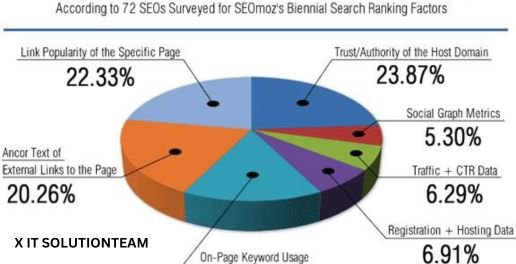
What is SEO and how does it work?
Discover what is SEO and how does it work? to improve your website’s rankings. Learn essential strategies for better visibility and success.
What is SEO and how does it work?
Introduction
Search Engine Optimization (SEO) is more than just a buzzword—it’s a critical strategy for anyone looking to grow their online presence. If you’ve ever wondered, What is SEO and how does it work?, this guide will provide clarity. Whether you’re a business owner, blogger, or curious learner, understanding SEO can unlock opportunities to drive organic traffic, enhance user experience, and boost your website’s visibility. Let’s explore this essential topic in detail.
What is SEO and how does it work?
What is SEO?
SEO, or Search Engine Optimization, refers to the practice of optimizing your website to rank higher on search engine results pages (SERPs). By improving your site’s structure, content, and user experience, SEO helps search engines understand your website better, making it more likely to appear for relevant queries.
At its core, SEO ensures that your content aligns with what users are searching for, while also meeting the technical requirements of search engines like Google, Bing, and Yahoo.
What is SEO and how does it work?
Why is SEO Important?
SEO (Search Engine Optimization) is an essential digital marketing strategy that impacts businesses, websites, and users in profound ways. By optimizing your online presence, you improve visibility, attract organic traffic, and foster trust among your audience. Here’s a closer look at why SEO matters and how it can benefit your website.
What is SEO and how does it work?
Increases Website Traffic
One of the most significant advantages of SEO is its ability to drive organic traffic to your site. Unlike paid advertising, which requires constant investment, organic traffic comes from people who find your site naturally through search engines.
For instance, when someone searches for a product or service you offer, effective SEO ensures your website appears prominently in the search results. This visibility can significantly boost the number of visitors to your site, increasing your chances of conversions and sales. Importantly, because organic traffic is free, it allows businesses of all sizes to compete on a level playing field, making SEO an invaluable tool for growth.
What is SEO and how does it work?
Improves User Experience
SEO isn’t just about optimizing for search engines; it’s also about creating a better experience for your users. A website that loads quickly, is easy to navigate, and contains high-quality content will not only rank higher on search engines but also keep visitors engaged.
For example, mobile-friendly websites with clean layouts and helpful content encourage users to stay longer, explore more pages, and take desired actions. Search engines like Google reward such user-focused improvements by boosting your rankings. Consequently, improving user experience through SEO helps you build a loyal audience that returns to your site over time.
What is SEO and how does it work?
Builds Credibility and Trust
Websites that appear at the top of search engine results pages (SERPs) are often seen as more credible and trustworthy. Users tend to associate higher rankings with authority and reliability, even if they’re unfamiliar with the brand.
SEO builds trust by optimizing critical elements like secure connections (HTTPS), fast-loading pages, and valuable, relevant content. By consistently meeting these criteria, you not only please search engines but also create a positive impression among your visitors. Over time, this trust translates into stronger brand loyalty and higher customer retention.
What is SEO and how does it work?
Cost-Effective Marketing
Compared to other digital marketing strategies, SEO offers a cost-effective way to promote your website and attract potential customers. While paid ads can generate quick results, they require ongoing investment. In contrast, SEO’s benefits accumulate over time, providing long-lasting visibility and traffic without continuous spending.
For instance, a well-optimized blog post can keep bringing in traffic for years after it’s published, making SEO an excellent long-term investment. By focusing on high-quality content, strategic keyword usage, and technical optimization, businesses can achieve sustainable growth at a fraction of the cost of paid campaigns.
What is SEO and how does it work?
How Does SEO Work?
Search Engine Optimization (SEO) is a dynamic process that ensures your website aligns with search engine algorithms to rank higher on search engine results pages (SERPs). This alignment enhances visibility, attracts organic traffic, and improves user engagement.
What is SEO and how does it work?
Crawling and Indexing
The first step in SEO is for search engines to discover your content. This process, known as crawling, involves the use of automated programs called bots or spiders. These bots systematically browse the internet, visiting web pages and following links to uncover new or updated content.
During this phase search engines analyze and store your website’s content in a vast database. The indexed information includes text, images, metadata, and other relevant details that help search engines understand your site’s purpose and value.
For example, if you’ve published a blog post about “best hiking gear,” the search engine’s bots will crawl the page, extract key details, and store it in their index. When a user searches for hiking gear-related terms, the search engine retrieves this indexed information to match the query.
What is SEO and how does it work?
Ranking Factors
After indexing, search engines use algorithms to evaluate and rank your content. These algorithms consider multiple factors to determine your website’s relevance and authority for a given query. Key ranking factors include:

- Relevance to Search Queries: Your content must align with the user’s intent, answering their question or providing the information they seek.
- Keywords and Metadata: Proper usage of keywords in titles, headings, and descriptions signals the content’s focus to search engines.
- Site Speed and Mobile-Friendliness: Websites that load quickly and provide a seamless experience across devices rank higher.
- Quality Backlinks: Links from reputable websites act as endorsements, boosting your credibility and authority.
For instance, if a travel website links to your “best hiking gear” blog post, this backlink strengthens your content’s authority, increasing its chances of ranking well.
What is SEO and how does it work?
Delivering Results
Once your website is crawled, indexed, and evaluated, search engines deliver results when users enter search queries. This process happens in milliseconds, with search engines analyzing their indexed data to present the most relevant and authoritative pages.
The results are displayed in a ranked list, with higher-ranking pages typically receiving more clicks. Features like featured snippets, image packs, and knowledge panels can also enhance visibility.
For example, if someone searches “best hiking gear for beginners,” search engines will prioritize well-optimized content that includes relevant keywords, high-quality links, and detailed, user-focused information.
What is SEO and how does it work?
Key Components of SEO
1. On-Page SEO
This focuses on optimizing individual pages to rank higher. Essential aspects include:
- Keyword Optimization: Use relevant keywords in titles, headings, and body content.
- Meta Descriptions: Write concise descriptions that entice clicks.
- Image Alt Text: Describe images for better accessibility and rankings.
2. Off-Page SEO
Activities outside your website that influence rankings, such as:
- Backlink Building: Earning links from authoritative websites.
- Social Signals: Sharing content across social platforms.
3. Technical SEO
The foundation of a well-functioning website includes:
- Fast-loading pages
- Mobile responsiveness
- Secure connections (HTTPS)
What is SEO and how does it work?
How to Start with SEO
If you’re new to Search Engine Optimization (SEO), getting started may seem overwhelming, but it doesn’t have to be. By following a systematic approach, you can set the foundation for a successful SEO strategy.
What is SEO and how does it work?
Perform Keyword Research
The first step in SEO is understanding the terms and phrases your target audience is using to search for your products, services, or content. This process, known as keyword research, helps you identify relevant keywords to optimize your content.
Tools like Google Keyword Planner, SEMrush, and Ahrefs are excellent for uncovering keywords with high search volume and manageable competition. Focus on long-tail keywords—specific phrases that are more likely to convert because they target users with clear intent.
For example, instead of targeting the broad term “hiking gear,” aim for a more specific phrase like “best lightweight hiking gear for beginners.” Such keywords help you connect with users searching for exactly what you offer.
What is SEO and how does it work?
Optimize Your Website
Once you’ve identified your target keywords, the next step is to integrate them into your website. Optimization includes:
- Titles and Headings: Use your primary keyword in page titles and headings to signal relevance to search engines.
- URLs: Keep URLs short, descriptive, and keyword-rich.
- Content: Naturally incorporate keywords throughout your content without overstuffing.
Additionally, ensure your website is fast, mobile-friendly, and easy to navigate. Search engines prioritize user-friendly websites, so technical SEO plays a critical role in your rankings.
What is SEO and how does it work?
Create High-Quality Content
Content is the backbone of SEO. Creating valuable, engaging, and original content establishes your authority in your niche and keeps users returning to your site. Focus on addressing your audience’s needs and providing solutions to their problems.
For instance, if you’re targeting the keyword “best lightweight hiking gear for beginners,” write a comprehensive blog post that reviews popular options, includes user tips, and provides actionable recommendations. Visual elements like images, videos, and infographics can further enhance the user experience and improve engagement.
What is SEO and how does it work?
Build Backlinks
Backlinks—links from other websites to your own—are a key ranking factor in SEO. To build backlinks, consider:
- Collaborating with Bloggers: Reach out to bloggers in your niche for guest posting opportunities.
- Creating Shareable Content: Infographics, research studies, and detailed guides often earn natural backlinks.
- Leveraging Directories: Submit your website to reputable online directories for additional exposure.
Quality matters more than quantity, so prioritize backlinks from authoritative and relevant sites.
What is SEO and how does it work?
Track Performance
The final step in starting with SEO is monitoring your progress. Use analytics tools like Google Analytics and Google Search Console to measure traffic, keyword rankings, and user behavior. These insights help you identify what’s working and what needs improvement.
For example, if a specific blog post is driving most of your traffic, analyze why it’s performing well and replicate its success in other content.
What is SEO and how does it work?
The Role of Keywords in SEO
Keywords act as the bridge between your content and search engine queries. Strategically placing them in your content improves its chances of ranking. However, avoid keyword stuffing—it’s about relevance, not repetition.
What is SEO and how does it work?
Common SEO Mistakes to Avoid
- Ignoring mobile optimization
- Overlooking local SEO opportunities
- Using outdated tactics like keyword stuffing
- Neglecting meta descriptions and alt text
What is SEO and how does it work?
Tools to Simplify SEO
Several tools can help streamline your SEO efforts:
- Google Analytics: Tracks website performance.
- Ahrefs: Provides insights on backlinks and competitor strategies.
- Yoast SEO/Rank Math: Optimizes WordPress content for better rankings.
What is SEO and how does it work?
Frequently Asked Questions
What are backlinks in SEO?
Backlinks are links from external websites to your own. High-quality backlinks signal credibility and improve rankings.
Is SEO better than paid ads?
Both have their place, but SEO offers sustainable, long-term results, whereas paid ads provide immediate visibility.
How often should I update my SEO strategy?
SEO is dynamic. Regularly update strategies to align with algorithm changes and market trends.
Conclusion
SEO is a powerful tool for anyone looking to grow online. By understanding what SEO is and how it works, you can create a robust strategy to improve rankings, increase traffic, and achieve your digital goals. Remember, patience and consistency are key in SEO success.







